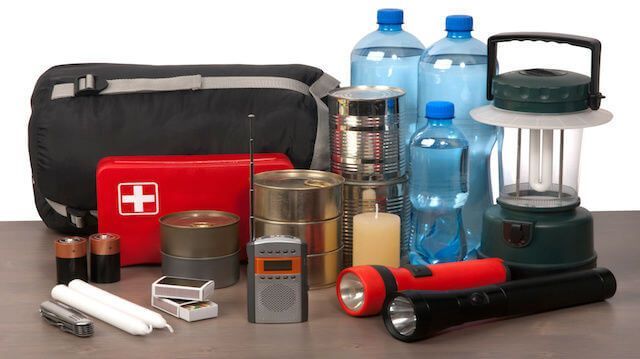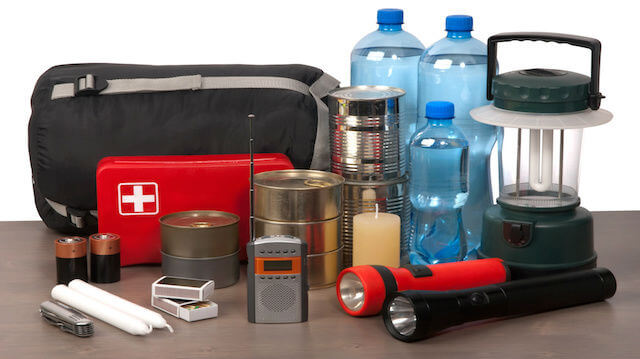
It is autumn and winter is fast approaching. ‘Tis the season for end of the year trips, winter sports and festive holiday cheer. It is also the time of year when Mother Nature is more apt to strike. Hurricanes and huge winter storms can debilitate and crush a community’s infrastructure within 12 hours.
Being prepared in any disaster is essential to survival and could very well be the difference between life and death. You may be asking yourself, “What do I get, how much of it and where or how do I store all this stuff?” The Federal Emergency Management Agency (FEMA) suggests that households have three days of water and food prepared and ready in case of an emergency.
FEMA also keeps your health and nutrition in mind as it gives a few nutrition tips published in Food and Water in an Emergency (2004), in collaboration with the American Red Cross. The disaster guide suggests, “During and after a disaster, it is vital that you maintain your strength.”
Here are four of FEMA’s disaster and emergency nutrition tips:
- Eat at least one well-balanced meal each day.
- Drink enough liquid to enable your body to function properly (two quarts or a half gallon per day).
- Take in enough calories to enable you to do any necessary work.
- Include vitamin, mineral, and protein supplements in your stockpile to ensure adequate nutrition.
The preparedness site, Ready, a national public service advertising (PSA) was developed in 2003 to assist in education and also empower Americans to be “ready” to respond to any future disasters and emergencies. The goal of the campaign is to “get the public involved and ultimately to increase the level of basic preparedness across the nation.” They advocate knowledge, planning, building a disaster kit and getting involved in your community’s emergency preparedness. There might be a lot of things you want to stuff into a bag or box to be ready for the next emergency situation. Having what you need is vital and having too much never hurts.
Let’s take a look at some essential items you should include when putting together your emergency preparedness kit.
Water. Water is one of the most crucial elements to your survival. Drinking one gallon of water per day is the average recommended amount. Keep three days of water, that is three gallons or more for each member of your family.
Tip: Fill your bathtub when you are aware of an approaching storm or possible disaster. You can use this water for cooking and to flush toilets.
Dried and canned fruit. Fruit provides vital sustenance in any emergency situation. Fruit contains the nutritional power of vitamins and minerals you need to stay healthy and focused in any period of peril.
Tip: Stock up on dried and canned fruit that is free of added sugars, preservatives, syrups, gels and artificial sweeteners.
Canned vegetables. Canned vegetables also offer you some excellent nutritional value during a survival situation.
Tip: Make sure your preparedness kit canned vegetables are low in sodium to ensure you are not taking in too much salt, which will subsequently make you thirstier. Also, do not forget the can opener.
Apples. With canned and dried fruit providing emergency nutrition, it is good to know which fruits have a longer shelf life. Apples are perfect in this regard and fresh is always a better alternative to anything canned. Apples are loaded with vitamin C and fiber, also containing 84 percent water, another hydration helper.
Tip: Choosing the right apples for storage is key. Jonathan apples keep far longer and if you wrap each apple in newspaper for storage, they may last upwards of 4 months.
Nuts. Having nuts in your disaster kit is another excellent choice. They provide a lot of useful protein. Depending on the situation, you may need protein sources to keep your body working in a stressful time.
Tip: Make sure the nuts you store are natural and not salted or covered in sugar. You want to avoid anything unhealthy. Salted nuts could also make you thirsty.
Here are a few non-food items useful in any disaster situation.
 Hand sanitizer. Although hand sanitizer is not the best option for scrubbing away germs and bacteria, you may need to really watch your water supply in an emergency.
Hand sanitizer. Although hand sanitizer is not the best option for scrubbing away germs and bacteria, you may need to really watch your water supply in an emergency.
Tip: Hand sanitizer that is 60 to 95 percent alcohol may be a better option for keeping harmful bacteria away.
First-aid Kit. A good first-aid kit is a vital part of any emergency kit. Things happen and when they do, you want to have the supplies and basic knowledge to close a wound and protect it from further injury or life-threatening infection.
Tip: In an emergency, the smallest injury could have severe consequences, so having a book and taking a few first-aid classes are essential.
Living in the Cascade Mountains of Oregon during my youthful years, we lost power regularly during the winter and would always have survival items ready to go. Our road was even swept away one year in a massive landslide. I remember that we always had an emergency bag in the car, gas tanks filled, and enough firewood to heat two homes. Even though I now live in South America, my preparation plan for disaster or infrastructure breakdown still follows the same principles.
Another great way to be prepared for anything is to make your disaster and emergency supplies mobile. Having everything in a big box or on your pantry shelves is excellent, but what if you need to get out in a hurry. Packing your survival goods in a few hiking packs, ready for you to “grab and go,” is another great alternative to improve your preparedness.
What is in your survival bag?
—Stephen Seifert
Stephen Seifert is a writer, professor, adventurer and a health & fitness guru. His flair for travel and outdoor adventure allows him to enjoy culture and traditions different than his own. A healthy diet, routine fitness and constant mental development is the cornerstone to Stephen’s life.
Sources:
https://www.fema.gov/pdf/library/f&web.pdf
http://www.ready.gov/food
http://www.ready.gov/about-us

